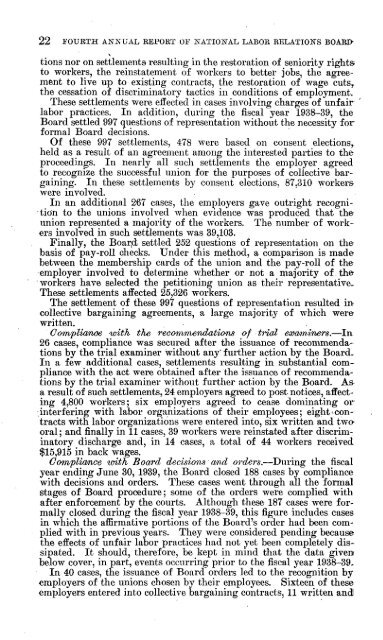J. - National Labor Relations Board
J. - National Labor Relations Board
J. - National Labor Relations Board
- No tags were found...
Create successful ePaper yourself
Turn your PDF publications into a flip-book with our unique Google optimized e-Paper software.
22 FOURTH ANNUAL REPORT OF NATIONAL LABOR RELATIONS BOARDtions nor on settlements resulting in the restoration of seniority rightsto workers, the reinstatement of workers to better jobs, the agreementto live up to existing contracts, the restoration of wage cuts,the cessation of discriminatory tactics in conditions of employment.These settlements were effected in cases involving charges of unfairlabor practices. In addition, during the fiscal year 1938-39, the<strong>Board</strong> settled 997 questions of representation without the necessity forformal <strong>Board</strong> decisions.Of these 997 settlements, 478 were based on consent elections,.held as a result of an agreement among the interested parties to theproceedings. In nearly all such settlements the employer agreedto recognize the successful union for the purposes of collective bar-(raining. In these settlements by consent elections, 87,310 workerswere involved.In an additional 267 cases, the employers gave outright recogni-•tion to the unions involved when evidence was produced that theunion represented a majority of the workers. The number of workersinvolved in such settlements was 39,103.Finally, the <strong>Board</strong> settled 252 questions of representation on the.basis of pay-roll checks. Under this method, a comparison is madebetween the membership cards of the union and the pay-roll of the.employer involved to determine whether or not a majority of the•workers have selected the petitioning union as their representative.These settlements affected 25,326 workers.The settlement of these 997 questions of representation resulted incollective bargaining agreements, a large majority of which werewritten.Compliance with the recommendations of trial eceaminers.—In26 cases, compliance was secured after the issuance of recommendationsby the trial examiner without any further action by the <strong>Board</strong>.In a few additional cases, settlements resulting in substantial compliancewith the act were obtained after the issuance of recommendationsby the trial examiner without further action by the <strong>Board</strong>. Asa result of such settlements, 24 employers agreed to post notices, affecting4,800 workers six employers agreed to cease dominating or.,interfering with labo r organizations of their employees; eight ,contractswith labor organizations were entered into, six written and twooral; and finally in 11 cases, 39 workers were reinstated after discriminatorydischarge and, in 14 cases, a total of 44 workers received$15,915 in back wages.Compliance with <strong>Board</strong> decisions and orders.—During the fiscalyear ending June 30, 1939, the <strong>Board</strong> closed 188 cases by compliancewith decisions and orders. These cases went through all the formalstages of <strong>Board</strong> procedure ; some of the orders were complied withafter enforcement by the courts. Although these 187 cases were formallyclosed during the fiscal year 1938-39, this figure includes casesin which the affirmative portions of the <strong>Board</strong>'s order had been compliedwith in previous years. They were considered pending becausethe effects of unfair labor practices had not yet been completely dissipated.It should, therefore, be kept in mind that the data givenbelow cover, in part, events occurring prior to the fiscal year 1938-39.In 40 cases, the issuance of <strong>Board</strong> orders led to the recognition byemployers of the unions chosen by their employees. Sixteen of these.employers entered into collective bargaining contracts, 11 written andl
















